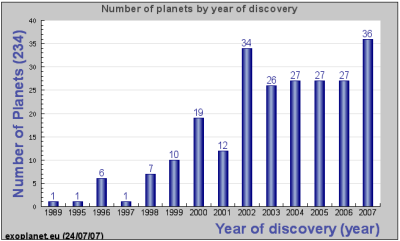Given that in the last ten years we have found roughly 250 planets outside our solar system, it is perhaps prudent to ask whether an alien civilization may have already detected our own planet and its biosphere during the approximately three billion years it has harboured photosynthesising life.
The Drake equation, the famous speculative tool to estimate the number of extraterrestrial civilizations in our galaxy with which we might come in contact, was not intended to address this question but can be modified to do so. Unfortunately (but perhaps not surprisingly) this exercise necessarily involves some mathematical notation, but bear with me – it is relatively simple and in the end you will have a tool to answer (or rather, speculate) this question yourself.
The Drake equation reads:
N = R* × fp × ne × fl × fi × fc × L
where N is the number of extraterrestrial civilizations which we might be able to contact, R* is the number of stars forming in the galaxy per year, fp the fraction of those stars that have planets, ne the average number of habitable planets per star that has planets, fl the fraction of habitable planets on which life emerges, fi the fraction of life-harbouring planets on which intelligence evolves, fc the fraction of civilizations that start to emit detectable signals into space, and L the average number of years such civilizations continue to emit signals into space.
Drake and his colleagues originally came up with N = 10. With different assumptions we can end up with vastly varying N values, ranging for example from 0.0000001 to 5000 (see examples here). But N is the estimated number of civilizations in the Milky Way which we might be able to contact, not the probability that the Earth and its biosphere have been detected by an extraterrestrial civilization sometime during the last three billion years. For that, we need to change the equation a bit.
Given a maximum detection distance from us, for each star within that distance there is a possibility that an alien civilization residing in that system has found Earth. That possibility can be quantified as probability:
p = fp × ne × fl × fi × fs × fd
where fp, ne, fl and fi are the same as in the Drake equation, fs is the fraction of civilizations that conduct exoplanet searches and fd is the fraction of Earth-like planets actually detected in those searches. This equation assumes that life and intelligence emerged always within the last three billion years, excluding the possibility of emergence and extinction before photosynthesising life appeared on Earth.
Given the probability of single detection above, we can formulate the probability that Earth has not been detected for a given number of stars S within the maximum detection distance:
p0 = (1 – p)S
Now let’s plug in some numbers. I assume that alien civilizations are interested in and capable of detecting Earth-like planets within 100 light-years from they home stars. According to the Gliese Catalogue of Nearby Stars, 3rd Edition, there are 1064 stars within 50 light-years from our solar system (although it is a conservative estimate because not all stars have been catalogued). After a bit of calculation using the volume equation of a sphere and assuming constant density of stars, we end up with 8512 stars within 100 light-years from us. This will be the value of S. For fs and fd we assign values 0.1 and 0.5, respectively, and for the rest of the variables we use the original values of Drake and his colleagues (fp = 0.5, ne = 2, fl = 1, fi = 0.01).
So, what is the probability that Earth has not been detected? It is 0.01, so the probability that Earth has been detected by an alien civilization is 0.99 or 99 percent. Now go speculate.



 Posted by archblogger
Posted by archblogger 